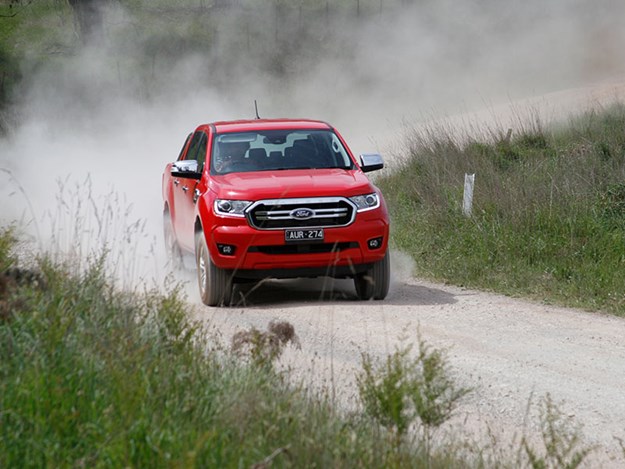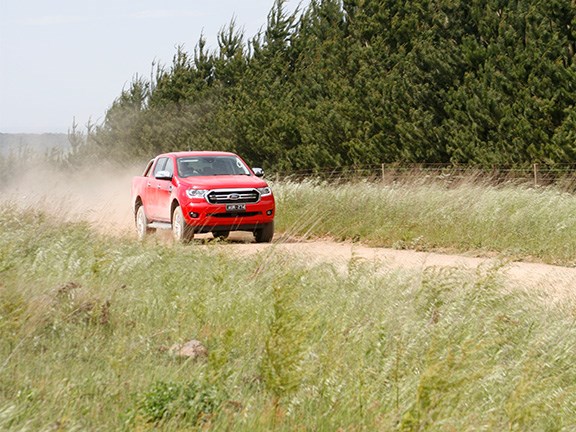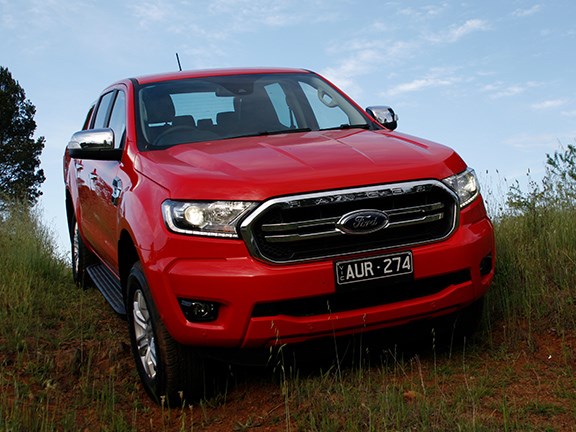Ford has enhanced the appeal of its strong-selling Ranger with the option of a new, more powerful and very high-tech engine and gearbox
 |
|
The XLT – the cheapest of the three Rangers available
|
You can now buy a Ford Ranger with a 10-speed automatic gearbox. Yes, you heard it right. A 10-speed automatic! And it’s mated up with a relatively small two-litre diesel engine fitted with a sophisticated bi-turbo arrangement rather than the usual single-turbo. This new engine will sell along the existing 3.2-litre five-cylinder diesel, the mainstay of the range, and the ‘budget’ 2.2-litre four-cylinder diesel.
But while this new engine is the smallest capacity now available in Ranger, it’s also the most powerful (210 horsepower or 157kW) and offers the most torque, an impressive 500Nm, that’s on tap at just 1,750rpm.
Climb aboard
This new engine is available in a number of Ranger models including three dual-cab 4WDs, the least expensive being the $59,390 XLT we have here. Other dual cab 4WDs with the new engine include the luxury Wildtrak model and the Raptor, which is a bespoke model along the lines of ‘Ranger meets off-road racer’.
Our test XLT is fitted with the optional leather seats ($1,700) and the ‘Tech Pack’ ($1,650), which brings features such as automatic emergency braking, adaptive cruise control, traffic-signal recognition and parking assist and a total price of $62,740, plus on-roads.
So, it’s not cheap, but it’s also very well equipped beyond what’s mentioned above, with features like sat-nav, auto headlights and wipers, dual-zone climate control, smart-phone connectivity, an 8-inch (203mm) touchscreen and newly fitted smart-key entry and push-button all standard.
The refreshed-for-2019 interior is well finished and, as ever, the Ranger’s cabin is big, comfortable and spacious and offers class-leading combined front to rear legroom. Some of the switchgear is still however a bit fiddly to use (like the air-con temp settings) and there’s still no reach adjustment for the steering wheel, only tilt adjustment. And if you happen to want the luxury of heated seats and/or electric seat adjustment, you’ll need to move up to a Wildtrak. All new Ranger models, even those with the other engines, get a new-look front-end and revised equipment lists.
 |
|
The small four-cylinder engine provides an effortless driving experience
|
On the road
So, the $6 million question? How does this new and relatively small four-cylinder engine go hauling around something as big and heavy as a Ranger? In a word, very well indeed. It simply doesn’t feel like a small engine and is effortless in normal driving and energetic if pressed hard. It’s both strong at low engine speeds but is also keen to rev out, such is the benefit of its bi-turbo arrangement where a small, quick-spinning turbo takes care of off-idle response while the second, bigger turbo kicks in when more power is needed at higher revs, all of which is done seamlessly. It’s certainly a completely different driving experience from the lazy, low revving, slightly more gruff, but more characterful 3.2-litre five-cylinder engine that’s been in this generation Ranger in one form or another since 2011 (see Ranger 2.0 vs. Ranger 3.2 box).
For its part, the gearbox offers near slick changes and pro-active shift protocols that find the right gear at the right time. Having so many gears also allows a wide ratio spread from the very tall top gear to a very short first gear but still with close ratio gaps in between. Ninth and tenth gears are both notably tall but the engine’s strong torque at low engine speeds (more than 3.2 in fact) means it can hold these taller gears at highway speeds with relative ease.
Good fuel economy too, which is also in contrast to the 3.2, a notably thirsty engine in this class.
As part of the 2019 Ranger revamp, the suspension has been revised for a more compliant side, less body roll and better steering, all of which builds on a ute that has always steered and handled well.
 |
|
Decent ground clearance, 17-inch AT tyres and a rear diff lock for more difficult terrain
|
In the paddock
The new engine and gearbox combination is mated up to the same part-time (driver selectable) 4WD system that’s always been in Ranger. Likewise, the 2.0-litre Ranger offers what you get with the 3.2: the same generous wheel travel, decent ground clearance, 17-inch (432mm) AT tyres (that look more like a road-pattern) and a rear diff lock should things get particularly difficult or slippery. Making things even better for the Ranger in difficult off-road conditions is in fact that the electronic traction control remains active on the front wheels when the rear locker is engaged, which is not always the set-up with some competitor utes.
Load and tow
Despite its much smaller capacity the new engine doesn’t diminish the Ranger’s excellent tow and payload ratings, namely 3,500kg and 1,000kg respectively.
To try out the new engine with a decent load we strapped 800kg of fencing wire in the tub (so close to max payload when you throw in driver and front passenger) to see how it would go. Ford says new suspension tune doesn’t effect load carrying but the impression on the road was that the chassis, while still very good, felt a little more nose-up and unsettled compared with the previous suspension set-up when carrying 800kg in the tray. Our up-coming dual-cab towing comparison test will hopefully throw more light on this.
No questions however about the engine’s ability to cope with this load as it remained effortless and fuss-free in general driving, as did the gearbox, which happily adjusted its shifts to cope with the extra weight.
Ownership
Ford now offers a five-year unlimited kilometre warranty, fixed price servicing and a loan-car programme to cover services. Ford also offers free upgrades of the sat-nav (new maps to reflect road changes) at scheduled regular services for up to seven years.
 |
|
The Ranger’s cabin is big, comfortable and spacious
|
Sum up
If you’re tossing up between a 2019 Ranger with this new 2.0-litre engine or one with the carried-over 3.2-litre, there’s a few things to consider.
Firstly, if you want a manual gearbox then the 3.2 is the only way to go, as the new 2.0-litre engine is not offered with a manual gearbox. Opting for a manual (a six-speed) also saves $2,200 over the 3.2’s six-speed automatic.
Secondly, in the popular XLT model as tested the here, the 2.0-litre comes at a $1,200 premium over a 3.2 automatic, which seems modest given the new engine brings marginally better performance, notably better fuel economy (around 10 to 15 per cent improvement) and is quieter and more refined.
The flip side of all new engine and gearbox is still an unknown quantity whereas the 3.2 powertrain is well proven. And being a bigger engine doesn’t work as hard to do the same job.
FORD RANGER XLT 2.0 SPECS:
Engine: 2.0-litre 4-cyl bi-turbo diesel
Max power: 157kW @ 3,750rpm
Max torque: 500Nm @ 1,750-2,000rpm
Gearbox: Ten-speed automatic
4X4 System: Dual-range part-time
Construction: Separate chassis
Front suspension: Independent/coil springs
Rear suspension: Live axle/leaf springs
Brakes: Discs front/drums rear
Wheel/tyre spec: 265/65R17 112T
Unladen weight: 2,197kg
GVM: 3,200kg
Payload: 1,003kg
Towing capacity: 3,500kg
GCM: 6,000kg
Overall length: 5,426mm
Width (inc. mirrors): 2,163mm
Height: 1,821mm
Wheelbase: 3,220mm
Track (F/R): 1,560mm/1560mm
Turning circle: 12.7m
Ground clearance: 237mm
Fuel tank capacity: 80 litres
ADR fuel claim: 8.4 litres/100km
Test fuel use: 9.4 litres/100km
RELATED ARTICLE


